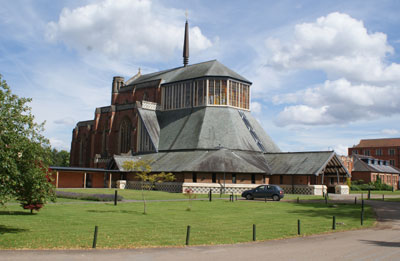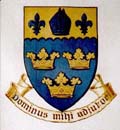
Abbey Church 2012
This text, courtesy of Mike Skivington.
The Bishop of Portsmouth, Bishop Cahill, offered the monks the buildings of a diocesan school at Woolhampton. The space was barely adequate for the boys of two schools as well as the monks and there were those who wanted to continue the search for a new home, however ultimately the decision was made to settle permanently in Woolhampton. Land was purchased and accommodation around the quadrangle increased including the extension including improved washing and toilet facilities. The first major project was to build a monastery separate from the school (the ark) and the block containing the refectories, kitchen and the brown dormitory. These were completed during the first world war. St Mary's church, which later became the school chapel, acted as the temporary Abbey Church. The first section of the new Abbey Church was opened in 1933. This was closed to the west of the sanctuary by a temporary wall. By 1985 this wall had become unsafe and a decision was taken to extend the church, using a design by Dr Michael Blee, which was more appropriate to post Vatican II liturgy. The Abbey Church was re-opened in 1993 (link to picture). Frederick Gibberd's design for new accommodation for the monks was accepted and the first section was built and came into use in early 1967. The development of the monastery buildings has continued, most recently with the addition of a library building opened by the Archbishop of Canterbury.
The first Abbot resigned soon after the move to England and the second Abbot retired after only a year. Abbot Taylor, the third holder of the office served his full term and was influential in the decision to make Woolhampton the permanent home for the community. Abbot Hurley commenced the building of new monastic buildings. Under Abbot Kelly novices returned to Douai from Fort Augustus and during his abbacy the foundation stone of the new Abbey Church was laid. Subsequently Abbot Kelly became Abbot President of the EBC. Abbot Sylvester Mooney, first elected in 1929, then begun what turned out to be a forty year reign at Douai. had been in the school when it transferred from France to England. He had trained in the common noviciate at Belmont and at Oxford University. During the latter part of his rule the foundation stone was put in place of Gibberd's new monastic buildings. When Abbot Gregory Freeman succeeded Abbot Mooney the latter refused a titular abbacy and returned to being Fr Sylvester. He lived to the age of 103! Abbot Gregory had to guide the monastery through the developments in the Church following the second Vatican Council, the reduction in the numbers of vocations and the ageing of remaining monks. He was re-elected for a third term when already seriously ill. Abbot Leonard Vickers returned from Washington to take over from Abbot Gregory but sadly he died suddenly after only a year in office. Much of the work in the completion of the Abbey Church took place during Abbot Finbar Kealy's abbacy but clouds were gathering over the future of the school which finally closed in 1999.
Anniversaries.
2003 marked the centenary of the return of the Douai community to England.
In 2015 the community will be celebrating the four-hundredth anniversary
of its foundation in Paris and three years later the bi-centenary of the
re-establishment of the community at Douai
The Abbots
Abbot Laurence Larkin 1900 - 1903
Abbot Ambrose Bamford !904 -1905
Abbot Stanislaus Taylor 1905 -1913
Abbot David Hurley (1913 -1921)
Abbot Edmund Kelly (1921 - 1929)
Abbot Sylvester Mooney 1929 -1969 -
Daily Telegraph Obituary
Abbot Gregory Freeman (1969 -1989)
Abbot Leonard Vickers (1989 -1990)
Abbot Finbar Kealy (1990 -1998)
Abbot Geoffrey Scott (1998 -

